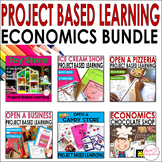Economics Unit and Entrepreneurship - Project Based Learning Open a Business
- Zip
What educators are saying
Also included in
- PROJECT BASED LEARNING (PBL): ECONOMICS BUNDLE : With this pbl ideas bundle, students learn about entrepreneurship, and economics. These student-centered PBL units incorporate collaboration and differentiation by providing student choice. The real-world challenges require students to use inquiry, crPrice $26.25Original Price $37.50Save $11.25
Description
Prepare your future entrepreneurs with this Project Based Learning Entrepreneurship, Economics unit for upper elementary students. Students learn about local businesses and how they can build their own small businesses with a business plan and marketing. This Open and Run a Business PBL unit includes differentiation, problem-solving, collaborative learning, technology, research, and 21st-century learning skills. This comprehensive economics and entrepreneurship unit focuses on grades 3-5. (Sixth grade can even benefit.) The activities are perfect to incorporate into any economics unit.
WHY TEACHERS LOVE PBL...
- This PBL unit incorporates 21st-century skills with challenging, engaging, and creative activities.
- There are lots of opportunities for differentiation, cooperative learning, and technology integration.
- This real-world challenge requires students to use inquiry, critical thinking, and creative minds during high-interest cross-curricular activities [math, STEM, social studies, ELA].
- Students love creating their own businesses.
- Easily adapted for enrichment or gifted students in other grade levels.
HOW THE RESOURCE CAN BE USED:
- Centers and stations
- Real-world learning
- Review skills
- Go along with a room transformation
- More practice
- Differentiation
- STEM
- Deepen learning
- Integrate 21st-century learning
- Advanced or independent learners
- Cooperative/collaborative learning
- Integrate multi-curricular activities
INCLUDED IN THIS UNIT:
Resources include books and recommended websites about economics and entrepreneurship
- What is an Entrepreneur?
- Character Traits of an Entrepreneur
- Research on Famous Entrepreneurs
- Character Traits of an Entrepreneur
- Henry Ford as an Inventor and Entrepreneur
- Thomas Edison bio and questions
- Think Outside the Box activities
- Questions I Have activity
- Business Affects Our Lives worksheet
- Choosing Your Business
- Starting a Business
- Brainstorming Goods and Services economics activity
- Compare and Contrast Goods and Services and Consumers and Producers economics activity
- Questions About My Business
- Developing a Driving Question
- Creating a Business Plan
- Brainstorming Names of Your Business and Slogans (With Slogan PowerPoint Game)
- Business Logos
- Business Plan – Marketing
- Business Flyer With Pic Collage with sample
- Business Survey
- Interview someone in business
- Business Cards
- Coupons
- Song or Jingle
- Video Commercial
- Presentation of project
- Journal Writing
- Giving Back PowerPoint
- Pdf Slideshow With Examples
- Reflections on the project
- Vocabulary
- Invitation to the Business Expo (Students can design their own)
Teachers love this activity because it can easily be adapted for enrichment or gifted students in other grade levels.
TEACHERS LIKE YOU HAVE SAID...
⭐️⭐️⭐️⭐️⭐️ “My students loved this project! I was looking for some project based learning and this fit my needs. I was able to pick and choose the activities to fit my students' needs and interests."
⭐️⭐️⭐️⭐️⭐️ “This was a hit in my class. We learned about economics and entrepreneurship at the end of the year. Even being the end of the year this project was fun, kept students focused and I was able to still see if students were understanding the topic.”
⭐️⭐️⭐️⭐️⭐️ “I work for a magnet school that focuses on Entrepreneurship. I wanted something my students could work on during small group time to encourage learning about entrepreneurship. I loved the different levels of learning this pack allowed for and how it taught different skills, such as research and writing.”
*******************************************************************
YOU MAY ALSO LIKE…
→ Project Based Learning Growing Bundle
→ Project Based Learning Units
→ Project Based Learning Digital Interactive Notebook
*******************************************************************
Copyright © Sweet Integrations. All rights reserved by the author.
Permission to copy for one classroom only. You can purchase additional licenses if more than one classroom uses the product.
© 2015 Google and the Google Apps are registered trademarks of Google Inc.
*******************************************************************
Follow Me for sales, product launches, and FREE resources.
*******************************************************************
Drop by my blog, Sweet Integrations for more ideas for your classroom!






